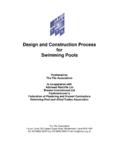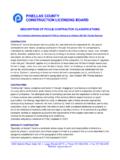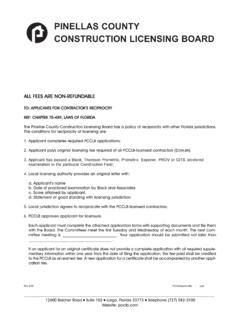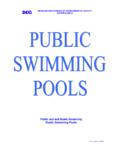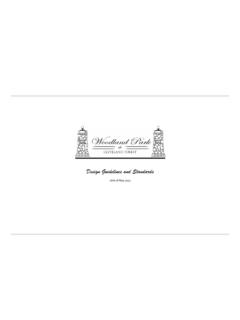Transcription of 1. Software Process Models - KTH
1 1. Software Process Models (Sommerville Chapters 4, 17, 19, ) A Software Process model is a standardised format for planning organising, and running a development project. 1 Hundreds of different Models exist and are used, but many are minor variations on a small number of basic Models . In this section we: survey the important basic Models , and consider how to choose between them. 2 Planning with Models SE projects usually live with a fixed financial budget. (An exception is maintainance?) Additionally, time-to-market places a strong time constraint.
2 There will be other project constraints such as staff. 3 Project constraints money time Computing resources staff Specialist technical staff management Support sales Examples of Project Constraints 4 Project planning is the art of scheduling/constraint solving the project parameters, along various dimensions: time, money, staff .. in order to optimise: project risk [low] (see later) profit [high] customer satisfaction [high] worker satisfaction [high] long/short-term company goals 5 Questions: 1. What are project parameters?
3 2. Are there good patterns of organisation that we could copy? 6 Project parameters describe the whole project, but we must at least describe: resources needed (people, money, equipment, etc) dependency & timing of work (flow graph, work packages) rate of delivery (reports, code, etc) It is impossible to measure rate of progress except with reference to a plan. 7 In addition to project members, the following may need access to parts of the project plan: Management Customers Subcontractors (outsourcing) Suppliers ( licenses, strategic partners) Investors (long term investment) Banks (short term cash) 8 Project Visibility Unlike other engineers ( civil, electronic, chemical.)
4 Etc.) Software engineers do not produce anything physical. It is inherently difficult to monitor an SE project due to lack of visibility. 9 This means that SE projects must produce additional deliverables (artifacts) which are visible, such as: Design documents/ prototypes Reports Project/status meetings Client surveys ( satisfaction level) 10 What is a Software Process Model? Definition. A ( Software /system) Process model is a description of the sequence of activities carried out in an SE project, and the relative order of these activities.
5 11 It provides a fixed generic framework that can be tailored to a specific project. Project specific parameters will include: Size, (person-years) Budget, Duration. project plan = Process model + project parameters 12 There are hundreds of different Process Models to choose from, : waterfall, code-and-fix spiral rapid prototyping unified Process (UP) agile methods, extreme programming (XP) COTS .. But most are minor variations on a small number of basic Models . 13 By changing the Process model, we can improve and/or tradeoff: Development speed (time to market) Product quality Project visibility Administrative overhead Risk exposure Customer relations, etc, etc.
6 14 Normally, a Process model covers the entire lifetime of a product. From birth of a commercial idea to final de-installation of last release The three main phases: design, build, maintain. (50% of IT activity goes here!) 15 We can sometimes combine Process Models 1. waterfall inside evolutionary onboard shuttle Software 2. Evolutionary inside waterfall GUI prototyping We can also evolve the Process model together with the product to account for product maturity, rapid prototyping waterfall 16 The Waterfall Model The waterfall model is the classic Process model it is widely known, understood and used.
7 In some respect, waterfall is the common sense approach. Royce, Managing the Development of Large Software Systems: Concepts and Techniques, Proc. IEEE Westcon, IEEE Press, 1970. 17 User Requirements Software Requirements Architecture Design Detailed design & Coding Testing Delivery The Waterfall Workflow Time User Requirements Document Software Requirements Document Architectural Design Document Detailed Design & Code phase output Swimming upstream 18 Advantages 1. Easy to understand and implement. 2. Widely used and known (in theory!)
8 3. Fits other engineering Process Models : civil, mech etc. 4. Reinforces good habits: define-before- design, design-before-code 8. Identifies deliverables and milestones 9. Document driven: People leave, documents don t Published documentation standards: URD, SRD, .. etc. , ESA PSS-05. 10. Works well on large/mature products and weak teams. 19 Disadvantages I 1. Doesn t reflect iterative nature of exploratory development. 2. Sometimes unrealistic to expect accurate requirements early in a project 3. Software is delivered late, delays discovery of serious errors.
9 4. No inherent risk management 5. Difficult and expensive to change decisions, swimming upstream . 6. Significant administrative overhead, costly for small teams and projects. 20 Code-and-Fix This model starts with an informal general product idea and just develops code until a product is ready (or money or time runs out). Work is in random order. Corresponds with no plan! (Hacking!) 21 Advantages 1. No administrative overhead 2. Signs of progress (code) early. 3. Low expertise, anyone can use it! 4. Useful for small proof of concept projects, as part of risk reduction.
10 22 Disadvantages 1. Dangerous! 1. No visibility/control 2. No resource planning 3. No deadlines 4. Mistakes hard to detect/correct 2. Impossible for large projects, communication breakdown, chaos. 23 Evolutionary Development Types Type 1: Exploratory Development: customer assisted development that evolves a product from ignorance to insight, starting from core, well understood components ( GUI?) Type 2: Throwaway Prototyping: customer assisted development that evolves requirements from ignorance to insight by means of lightweight disposable prototypes.


